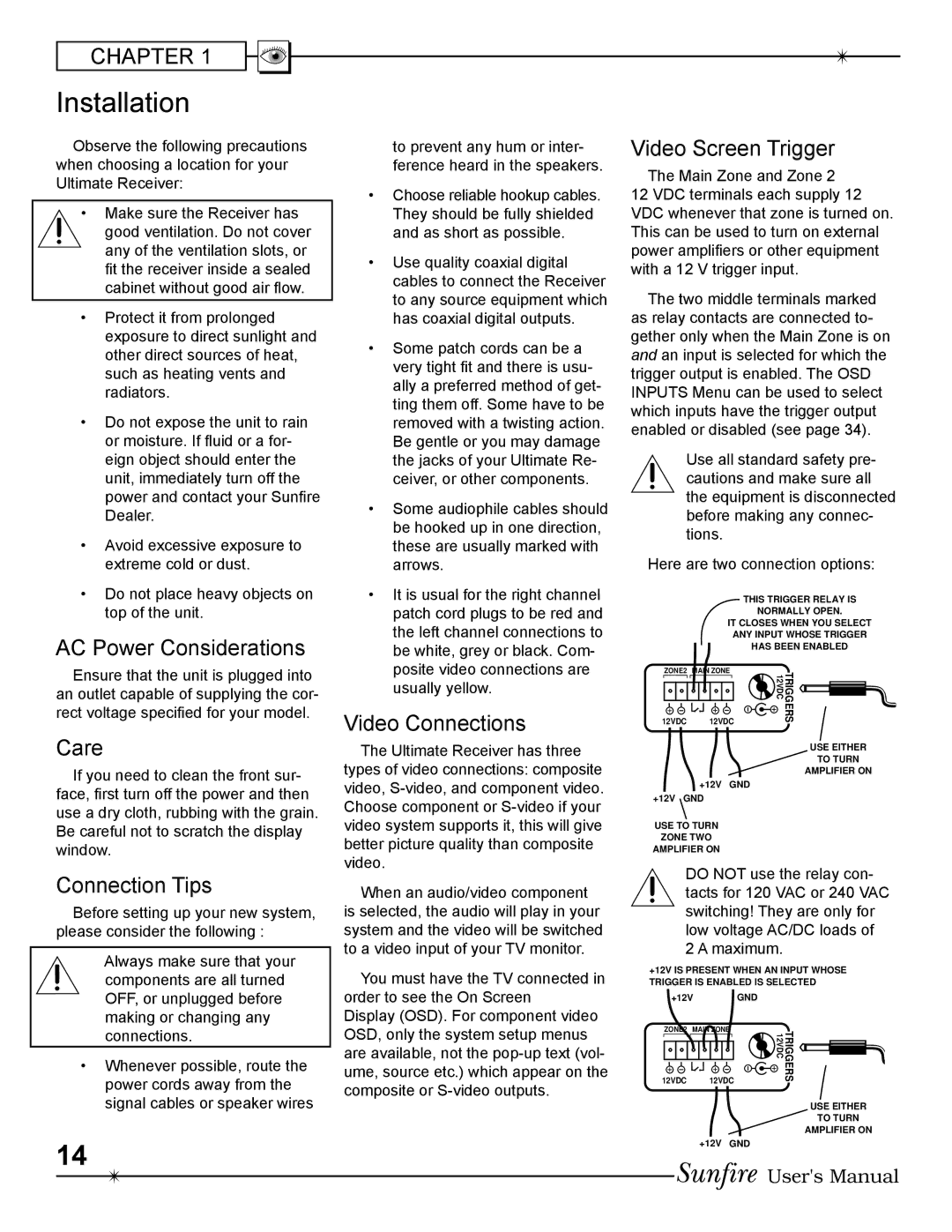
CHAPTER 1
Installation
Observe the following precautions when choosing a location for your Ultimate Receiver:
•Make sure the Receiver has good ventilation. Do not cover
any of the ventilation slots, or Þt the receiver inside a sealed cabinet without good air ßow.
•Protect it from prolonged exposure to direct sunlight and other direct sources of heat, such as heating vents and radiators.
•Do not expose the unit to rain or moisture. If ßuid or a for- eign object should enter the unit, immediately turn off the power and contact your SunÞre Dealer.
•Avoid excessive exposure to extreme cold or dust.
•Do not place heavy objects on top of the unit.
AC Power Considerations
Ensure that the unit is plugged into an outlet capable of supplying the cor- rect voltage speciÞed for your model.
Care
If you need to clean the front sur- face, Þrst turn off the power and then use a dry cloth, rubbing with the grain. Be careful not to scratch the display window.
Connection Tips
Before setting up your new system, please consider the following :
Always make sure that your components are all turned OFF, or unplugged before making or changing any connections.
•Whenever possible, route the power cords away from the signal cables or speaker wires
14
to prevent any hum or inter- ference heard in the speakers.
•Choose reliable hookup cables. They should be fully shielded and as short as possible.
•Use quality coaxial digital cables to connect the Receiver to any source equipment which has coaxial digital outputs.
•Some patch cords can be a very tight Þt and there is usu- ally a preferred method of get- ting them off. Some have to be removed with a twisting action. Be gentle or you may damage the jacks of your Ultimate Re- ceiver, or other components.
•Some audiophile cables should be hooked up in one direction, these are usually marked with arrows.
•It is usual for the right channel patch cord plugs to be red and the left channel connections to be white, grey or black. Com- posite video connections are usually yellow.
Video Connections
The Ultimate Receiver has three types of video connections: composite video,
When an audio/video component is selected, the audio will play in your system and the video will be switched to a video input of your TV monitor.
You must have the TV connected in order to see the On Screen Display (OSD). For component video OSD, only the system setup menus are available, not the
Video Screen Trigger
The Main Zone and Zone 2 12 VDC terminals each supply 12 VDC whenever that zone is turned on. This can be used to turn on external power ampliÞers or other equipment with a 12 V trigger input.
The two middle terminals marked as relay contacts are connected to- gether only when the Main Zone is on and an input is selected for which the trigger output is enabled. The OSD INPUTS Menu can be used to select which inputs have the trigger output enabled or disabled (see page 34).
Use all standard safety pre- cautions and make sure all the equipment is disconnected before making any connec- tions.
Here are two connection options:
THIS TRIGGER RELAY IS
NORMALLY OPEN.
IT CLOSES WHEN YOU SELECT
ANY INPUT WHOSE TRIGGER
HAS BEEN ENABLED
ZONE2 | MAIN ZONE | TRIGGERS |
12VDC | 12VDC | |
12VDC |
|
USE EITHER
TO TURN
AMPLIFIER ON
+12V GND
+12V GND
USE TO TURN
ZONE TWO
AMPLIFIER ON
DO NOT use the relay con- tacts for 120 VAC or 240 VAC switching! They are only for low voltage AC/DC loads of 2 A maximum.
+12V IS PRESENT WHEN AN INPUT WHOSE TRIGGER IS ENABLED IS SELECTED
+12VGND
ZONE2 | MAIN ZONE | TRIGGERS |
12VDC | 12VDC | |
12VDC |
|
USE EITHER
TO TURN
AMPLIFIER ON
+12V GND
User's Manual
